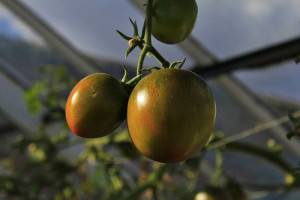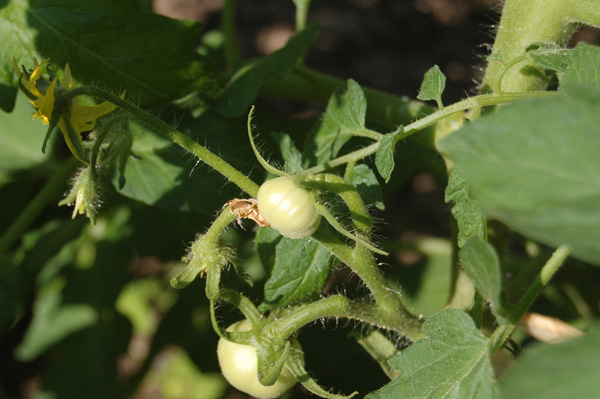Learn how to grow tomatoes from a master
I do not claim to be an expert gardener or tomato producer but I did know a man who was, my father who was an absolute perfectionist in everything he did and growing tomatoes was no exception. So to learn how to grow tomatoes in a greenhouse you need to read this article.
 For years my father spent every minute of his spare time in the garden, originally it was out of a pure need to feed the family. Times were a little hard financially when we were all kids and my father had been brought up in an environment of self sufficiency which not only meant growing vegetables in the garden but also included rearing and slaughtering a family pig to provide the meat for a year.
For years my father spent every minute of his spare time in the garden, originally it was out of a pure need to feed the family. Times were a little hard financially when we were all kids and my father had been brought up in an environment of self sufficiency which not only meant growing vegetables in the garden but also included rearing and slaughtering a family pig to provide the meat for a year.
Hard to believe, in these days of fast food and supermarkets which supply every kind of produce that you can imagine from all around the world, that I am only talking about one generation removed. Where, literally, if you could not grow your own vegetables there was a good chance you were going to go hungry.
Clearly over the years things improved and gardening out of necessity turned into gardening for the love for it. There is a lot of satisfaction to be gained from growing your own fruit and vegetables, being able to put the freshest possible produce on the table and to have the satisfaction of having grown it yourself.
My father, as he was, could not help himself from turning the extra he produced into a tidy little profit by selling it on to the local villagers who would be very happy to pay for the extra vegetables and tomatoes that were invariably available. He had in absolute abundance what we, and many others, referred to as ‘green fingers’.
 Of course as a child and given the work ethic of the family, we all had to do our bit to contribute and I remember many hours spent helping my father, building a greenhouse, digging the soil and of course when necessary planting and watering the vegetables. I like to think that during these times I picked up a few tips for growing tomatoes and other plants along the way, but it was tomato growing that became my fathers passion and the subject I am going to discuss in detail here.
Of course as a child and given the work ethic of the family, we all had to do our bit to contribute and I remember many hours spent helping my father, building a greenhouse, digging the soil and of course when necessary planting and watering the vegetables. I like to think that during these times I picked up a few tips for growing tomatoes and other plants along the way, but it was tomato growing that became my fathers passion and the subject I am going to discuss in detail here.
Given that we lived in the UK it was pretty much essential that the tomatoes were grown in a greenhouse, I will leave you to surmise why, but a greenhouse became one of the number one essential tools for growing the best tomatoes the village had to offer.
So lets get to what you are interested in, how did he actually do it?
It actually breaks down into four distinct areas of tomato cultivation: –
- Soil preparation
- How to plant tomatoes
- How to support the tomatoes
- How to care for tomatoes
Soil Preparation
The tomatoes would be planted straight into the ground inside the greenhouse, so in order to prepare for the planting a ditch would be dug about 18″ deep. The bottom of the ditch was filled with a mulch to form a 6″ layer or so, on top of that was placed a mixture of soil and compost, ideally the compost was rich in nitrogen and typically made from grass cuttings, kitchen vegetable waste, annual weeds (i.e. once pulled would not recover or try to re-root) and, if you have access to it, well rotted manure. You can of course add a further layer of mulch on the surface of the soil, as is more traditional, to help with weed control and moisture retention. For tomatoes a coffee ground mulch is a good idea as this will contain a reasonable amount of nitrogen which will help supplement the fertilizer. Remember to wait until the plants are in and established with the soil nicely warmed before adding a mulch to the surface.
How to Plant Tomatoes
The tomatoes themselves, whether grown from seed, or bought as plants would be planted fairly deep, remember that tomatoes can develop roots from any part of the stem so putting them in deep is not a problem. The lower part of the plant would have any offshoots removed so that it is easier to plant them deep and also to ensure there is no contact with the ground.
How to Support Tomatoes
In a greenhouse it can be a little tight for space, or certainly any I have been involved with that has been the case, so a neat way of supporting the tomatoes is to drive 3 decent sized stakes into the ground at either end of your planting row and to run gardening string fairly taught between them. The plants then grow through and hang over the string like a vegetable washing line. Obviously you have to use string that can take the weight and if you are planting a long run you may need extra stakes along the length, try and do this up front though , because you do not want to disturb the roots later on, soft string is the best product for this because tomato plants can bruise easily so need a nice soft material to support them.
How to care for tomatoes
Caring for tomatoes once planted is relatively easy but very important. You need to keep a careful eye on them for disease and pests, any leaves that look ill or suffering should simply be removed, bagged and binned. Occasional spraying with a pesticide should be done as required to keep the predators under control and other than that it is supplementing the plants with a suitable tomato feed, this should be done twice per week.
Watering should be done 2 or 3 times a day, the objective being to never let the soil dry out completely but also not over drenching either. When the fruit is ripening you can back off on the watering a little to help firm the fruit up, how much you back off is a bit of a judgement call based on how juicy versus tasty you like your tomatoes.
Now my father being the perfectionist he was, always insisted on warming the water to ambient temperature before watering. This was to ensure the plants were not shocked. it is a bit of a faff initially but once you get into the routine of simply refilling a few buckets after emptying them and sticking them back in the greenhouse overnight, that will be enough time for them to reach the required temperature. I can’t argue with his results so I am not going to disrespect his methods or attention to detail, he was the master.
Still on the subject of care and really most relevant to greenhouse growing, a couple of other tips are:
- ensure that the tomato plants do not get too hot, open the roof light and door of the greenhouse and if it is really hot you can whitewash the south facing side to reflect the sun away at the hottest part of the day.
- gently shake the plants when they are in flower to help pollination, I emphasize gently, remember there is no breeze inside a greenhouse so this is simply to aid a process that would normally happen naturally outside with a little bit of breeze going on.
You can actually buy mechanisms for opening and closing windows based on temperature if you would like to automate this process.
So that is it for now, the basics of tomato growing as taught by an old master.
I would imagine that I will be expanding on some of his other techniques for growing some other plants in time, for instance he was pretty legendary when it came to growing runner beans as well and he used to get them by the bucketful as sweet and tender as you could possibly imagine. So watch this space if you like what you have read so far.



tomato is good for the heart because it has lycopene..hence it is healthy to eat tomatoes…
.-= karen lopez´s last blog ..You Are Just A Dream =-.
Brian, nice piece. I enjoyed reading about your father, and love the tips on growing tomatoes. I will definitely be back to learn more. Have terrible luck with my tomatoes. I am trying to go all organic and they get some kind of fungus every year no matter what I do. Course, the intense heat this year — especially because it warmed up 20 degrees almost overnight here in Texas – has played havoc with the whole garden.
.-= Maryann Miller´s last blog ..Away From My Office =-.
He was the master really, I listened and learned but he forgot more than I ever learned and he just had those fabled green fingers, he couldn’t go wrong whatever he grew just flourished.